Rodenheim Im Odenwald HO scale.
Douglas Rhodes.
This article describing a German layout in HO scale appeared in the CONTINENTAL MODELLER magazine in April 2012. It is included here with the kind permission of the editor.
Like many model railway layouts Rodenheim was initially inspired by seeing an example of the real thing.
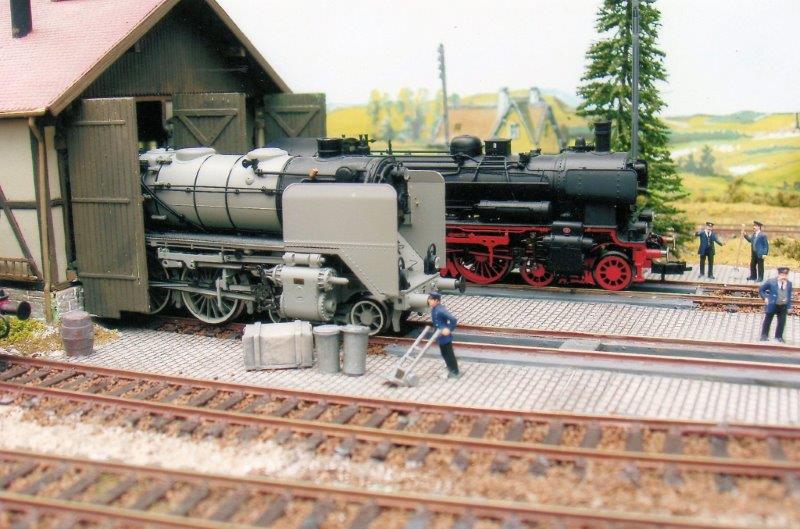 BR62 4-6-4T in photographic grey and BR38 4-6-0 emerge from the two road engine shed at Rodenheim.
BR62 4-6-4T in photographic grey and BR38 4-6-0 emerge from the two road engine shed at Rodenheim.
While staying with German friends near Frankfurt-am-Main my host Ulrich Stappenbeck kindly took me one Sunday morning to the small railway museum at Darmstadt-Kranichstein. Here set around an engine shed and turntable was an impressive collection of steam, diesel and vintage electric locomotives plus an array of passenger and freight rolling stock. The sight of such an eclectic group of locomotives made a profound impression and significantly for me meant that my next modelling project would be a Bahnbetriebswerk or motive power depot set in the attractive Odenwald district of western Germany.
 An overall view of the layout complete with a German flag.
An overall view of the layout complete with a German flag.
Being restricted to a six by two feet baseboard small enough to be transported in my car to local exhibitions meant that a faithful replication of Darmstadt-Kranichstein's track plan was out of the question. Less ambitiously I simply wanted to create a model which reflected the essence of what I had seen that morning.
Then I remembered seeing Graham Lightfoot's BW Bad Mainfeld layout in the 1991 July/August Continental Modeller. Fortunately I had saved the copy!
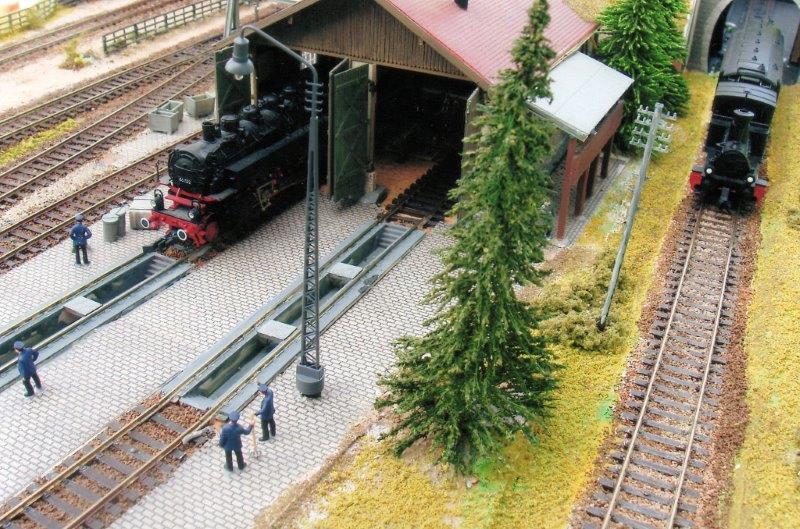 This view of the shed from the operators side of the layout shows the inspection pits and the local train emerging from the fiddle yard on the shuttle line.
This view of the shed from the operators side of the layout shows the inspection pits and the local train emerging from the fiddle yard on the shuttle line.
Being a fellow member of the German Railway Society I felt I could write to Graham who proved to be most encouraging and helpful. Of course I could not simply produce a carbon copy of his layout -1 needed to be a little more inventive - and so I decided to turn Graham's track plan 'inside-out' so that the engine shed, its main feature, appeared at the rear rather than at the front of the layout! In doing so locomotives would still have to use a head shunt before reversing towards the engine shed and thus maintain the operational interest of this small layout.
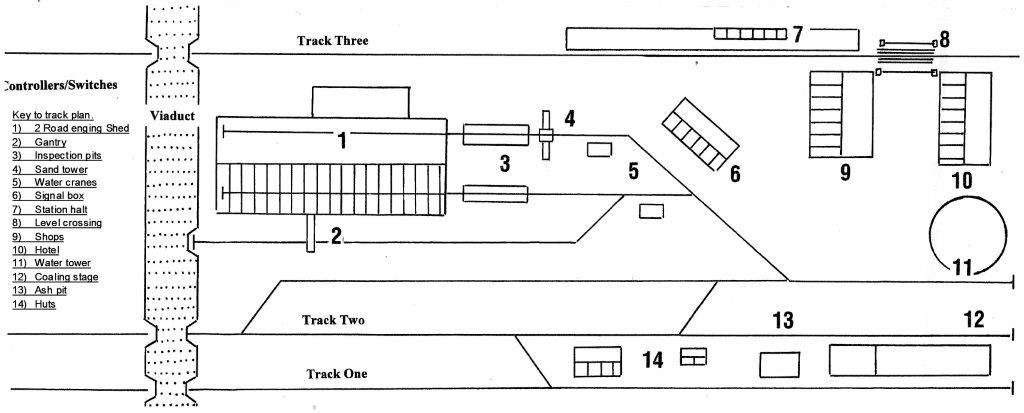 Line diagram of layout.
Line diagram of layout.
The Layout Described
On the left and separated by a viaduct is the non-scenic section providing space for the train controller, capacitor-discharge unit, electronic track cleaner, point control panel and light switches. Squeezed between these items are the extremities of the three running tracks. With only ten and a half inches to spare these could hardly form part of a proper 'fiddle yard' but nevertheless allow the locomotives the facility to 'hide' briefly before entering and after leaving the motive power depot.
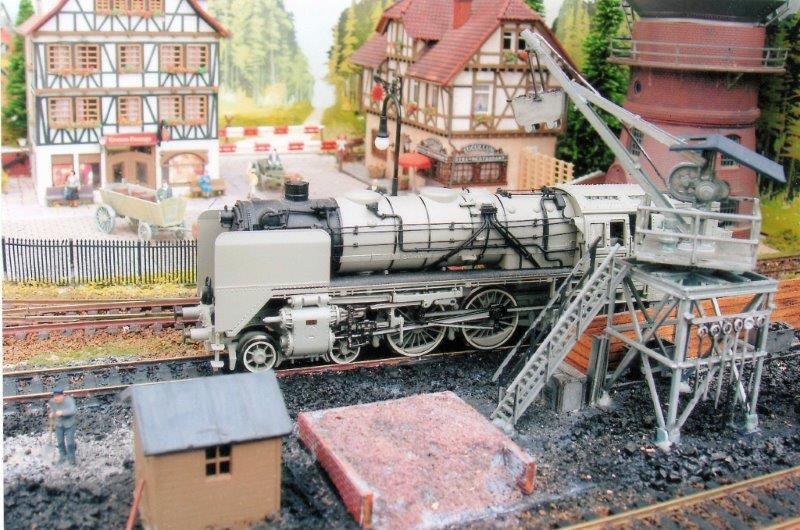 The BR62 4-6-4T pulls up to the coaling stage.
The BR62 4-6-4T pulls up to the coaling stage.
On Track One
A tiny Glaskasten engine appears from time to time with a loaded coal wagon and trundles across the front of the layout to replenish the coaling stage. The diminutive appearance of this engine never fails to make an impression with spectators.
On Track Two
Locomotives proceed into the MPD to avail themselves of the ash pit, coaling stage, water cranes, sand tower and engine shed itself with its inspection pits and maintenance gantry. A recently installed 'welding light' kit tucked inside the shed adds to the sense of activity.
On Track Three
At the rear of the layout an electric shuttle device enables a single coach passenger train to go back and forth at twenty second intervals between the viaduct and tiny passenger halt. Playing peek-a-boo with trees and buildings this feature not only puts two locomotives 'in steam' at the same time, adding more interest and entertainment value, but also allows the operator to pause occasionally without bringing all movement to a complete standstill. So important at exhibitions!
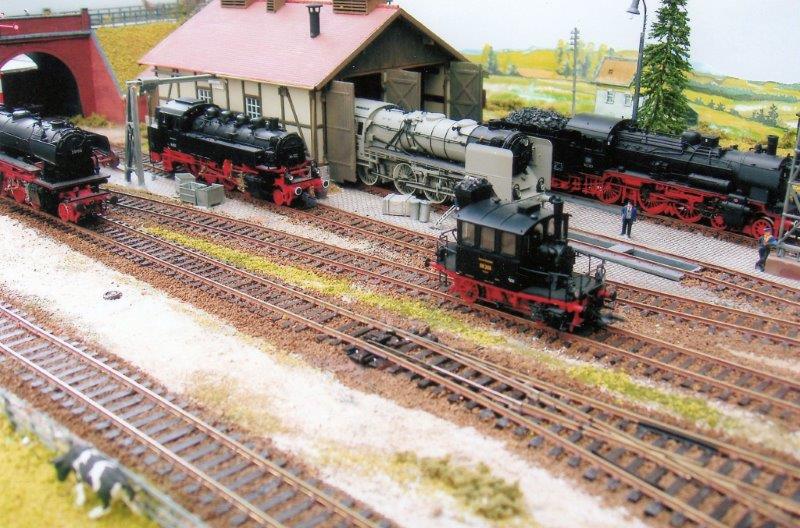 A full line-up of motive power outside the small engine shed - BR23 2-6-2, BR86 2-8-2T, BR62 4-6-4T, BR98.3 0-4-0T 'Glaskasten', and BR38 (a former Prussian P8) 4-6-0.
A full line-up of motive power outside the small engine shed - BR23 2-6-2, BR86 2-8-2T, BR62 4-6-4T, BR98.3 0-4-0T 'Glaskasten', and BR38 (a former Prussian P8) 4-6-0.
Buildings and MPD Installations
The timber framed buildings which are an important feature of Rodenheim are made from Faller and Kibri kits and are typical of the architecture to be seen in the Odenwald region. Indeed to my mind the nearby town of Michelstadt looks as if it has been lifted straight from the pages of these two manufacturers' catalogues!
When it came to providing the various items of equipment and installations to be found in a German MPD there was no problem. Following further advice from Graham Lightfoot I bought a copy of the splendid Eisenbahn Journal Special Bahnbetriebswerke Teil I: Kleine Lokstationen which is full of delightfully mouth watering pictures of all you need. In German thoroughness the magazine examines each item in turn, water towers and cranes, coaling stages and sanding towers produced by the various kit manufacturers. You simply make your choice and then enjoy assembling these superb kits. (For those with ambition to build a bigger German MPD there is Bahnbetriebswerke Teil 3 Grosser Lokstationen in the same series.) The table summarises the main propriety equipment and kits used.
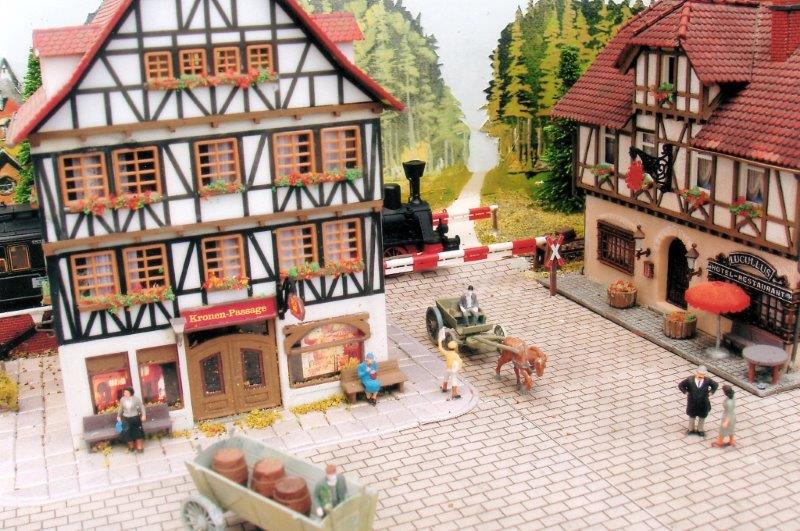 Motive power for the local train is a venerable 0-4-0T nicknamed "Black Anna" by the residents of the region.
Motive power for the local train is a venerable 0-4-0T nicknamed "Black Anna" by the residents of the region.
Track work:
Peco HO Code 75 with Peco point motors operated by the pencil and stud system, Locomotives: Six steam locomotives, mainly Epoch II Roco, Fleischman and Lilliput. Coaches and Wagons: Lilliput, Fleischman and Roco.
Buildings and MPD installations:
Mainly Faller and Kibri though the viaduct is from Hornby recycled from a previous layout.
People and animals: Preiser
Trees: Gaugemaster.
Scenic Background: MZD, much adapted.
Ballast and Foliage: Woodland Scenics and Greenscene.
Welding Unit: Modelex.
Controls:Gaugemaster - including shuttle unit, capacitor discharge unit and track cleaner.
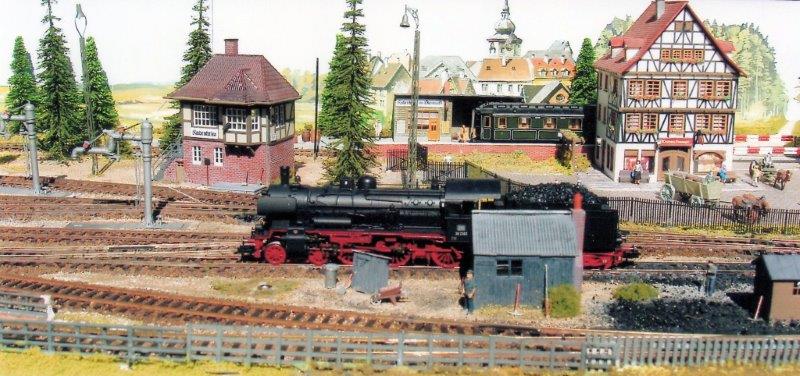 The BR38 moves off to it's next duty. Note the passenger train at the halt beyond.
The BR38 moves off to it's next duty. Note the passenger train at the halt beyond.
In its present form Rodenheim, whose name incidentally is an amalgam of two Odenwald towns, has now made nine public appearances and has inevitably undergone a few modifications during its short life.
Recently a dimmer switch has been added to the lighting system enabling the simulation of an evening scene. Buildings have had interior lights fitted while working yard lamps help to complete the effect.
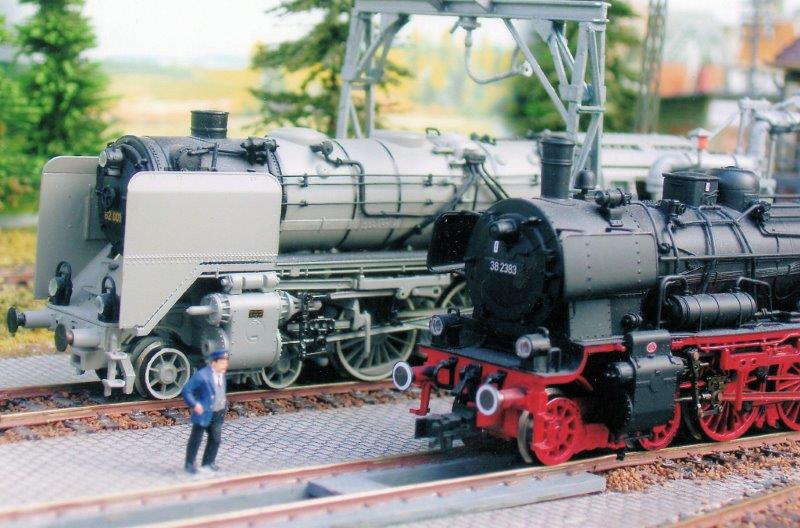 Outside the shed we see a BR62 4-6-4T in photographic grey and a BR38 4-6-0.
Outside the shed we see a BR62 4-6-4T in photographic grey and a BR38 4-6-0.
At the same time, and in the interest of authenticity, the front of the layout is adorned with a small map extract and photograph of the real life Odenwald village of Billings here masquerading as the fictitious Rodenheim!
Finally though the model has essentially been a one person production I would like to pay tribute to
Bob Compton a fellow member of the popular Association of Shrewsbury Railway Modellers for his advice on all things electrical, and to my wife Sue for 'scenic advice' and not least her patient forbearance. Time wise it is amazing how consuming this hobby of ours can be...........
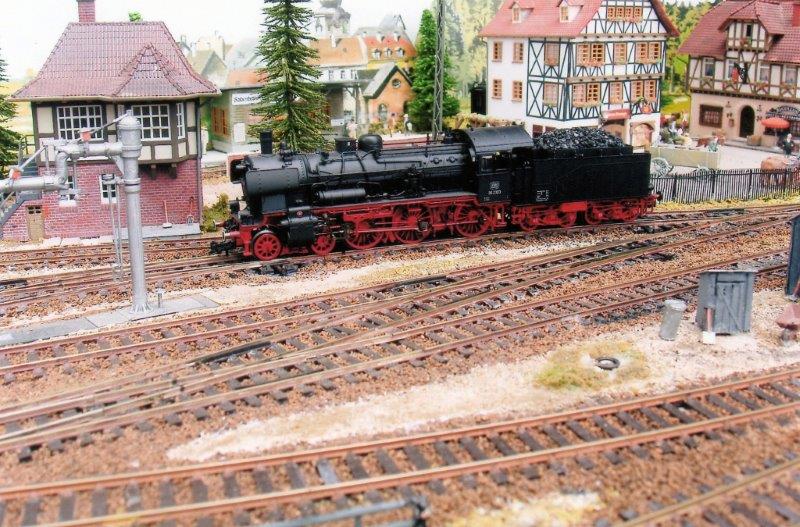 The BR38 runs slowly past the signal box.
The BR38 runs slowly past the signal box.